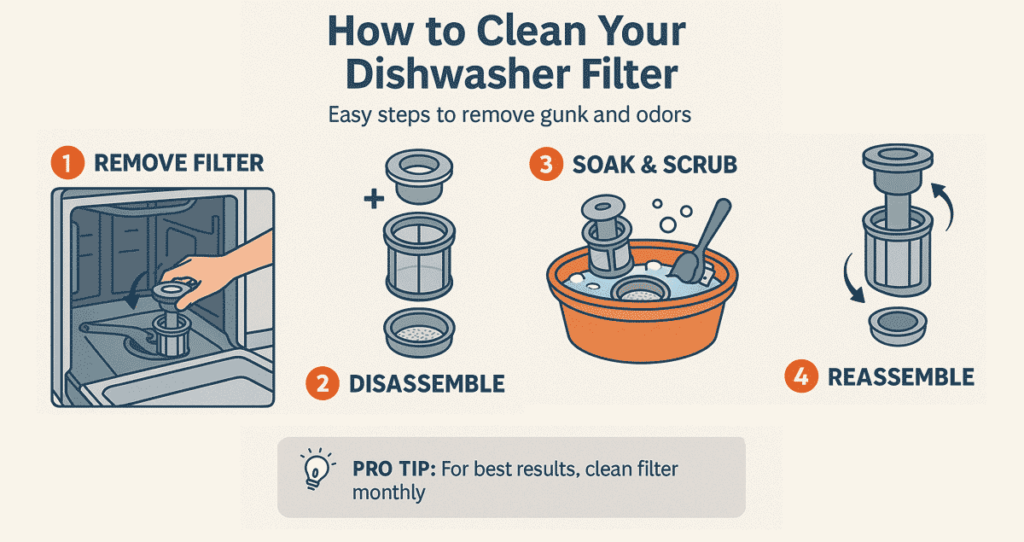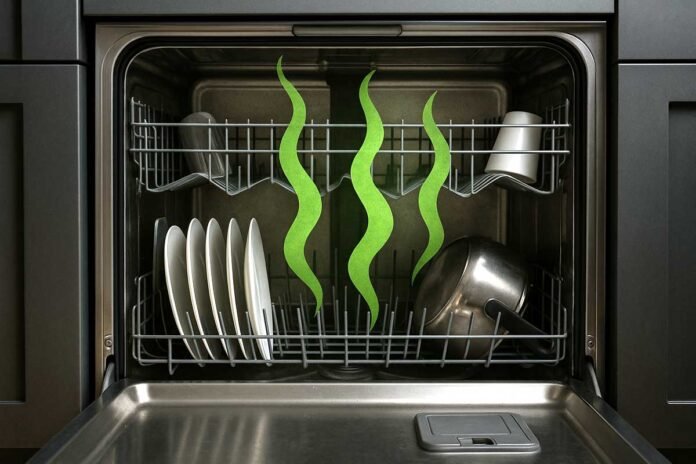If your dishwasher still smells after cleaning, you’re not alone. You gave your dishwasher a good scrub, maybe even ran one of those cleaning pods—and yet the smell is still inside. Funky. Damp. Slightly sour. Sound familiar?
Many U.S. households run into this exact issue. In most cases, it’s not about how often you clean—it’s about where and what you’re cleaning.
So let’s get straight to it—
Can a dirty filter cause a smell? Absolutely.
Does wiping the door seal actually help? More than you think.
Is it ever the drain hose? Yep—especially if it’s kinked or gunked up.
And no, running a cleaning pod isn’t a magic fix.
In this guide, we’ll uncover the most overlooked spots where odor hides, show you exactly how to fix the problem, and share smart habits that keep your dishwasher—and your dishes—smelling fresh every time.
👉 Stick with us—we’ll reveal exactly where that stinky treasure is hiding.
Why Your Dishwasher Still Smells After Cleaning – Even After a Full Clean
You’ve already wiped down the walls, ran a cleaning cycle, maybe even used vinegar or baking soda. But the smell? Still there. So what’s going on?
The truth is, most dishwashers have hidden spots that regular cleaning just doesn’t touch. And unless you know exactly where to look, the odor will keep coming back again and again like an unwanted houseguest.
Let’s break down the usual suspects.
1. Gunk in the Filter (The #1 Culprit)
The filter, located at the bottom of your dishwasher, is designed to trap food particles and prevent them from clogging the drain. Over time, and especially with regular or heavy use, those particles gradually break down. Eventually, they mix with grease and detergent residue to form a sticky, sludge-like gunk—something between wet paper and old chewing gum. As a result, this buildup starts to emit a foul odor, often compared to wet garbage or sour dishwater.
If you’ve never removed the filter and scrubbed it by hand, then it’s very likely that you haven’t given your dishwasher a proper deep clean. In fact, industry experts estimate that up to 80% of dishwasher odor issues originate right here—in this hidden, overlooked spot.
But here’s the twist: most people never even look under the lower rack. These hidden trouble zones—often only known by technicians and appliance pros—are the true root of persistent smell problems. Fortunately, we’ll walk you through exactly where to find them and how to clean them like a pro in the next sections.
Yes, it’s grosser than it sounds. You might be shocked by what’s hiding in there. However, the good news is that cleaning the filter is fast, simple, and incredibly effective. Even though it’s an unpleasant task, this one step alone can dramatically reduce odor—and the difference is immediate.
In short, don’t skip the filter. It’s not just a good place to start—it’s where most of the stink starts, and where you’ll see the biggest improvement once it’s clean.
2. Mold & Mildew in the Seals and Gaskets
Check the rubber seal around the door—run your finger along it and you’ll likely find black grime or slimy buildup. That’s mold and mildew, and it thrives in warm, damp environments like your dishwasher door frame.
Our Pro tip: Wipe it down with vinegar or a mild bleach solution every few weeks.
3. Food Debris in the Spray Arms or Drain Hose
Those spinning arms that spray water? Tiny holes can get clogged with rice, seeds, or soap scum. When that happens, water doesn’t rinse properly, and old food lingers in the machine.
Worse? If your drain hose is kinked or partially blocked, stagnant water collects and also starts to stink fast.
4. You’re Cleaning the Wrong Way
Running a cleaner pod or a vinegar cycle can definitely help reduce buildup. However, it’s not enough by itself. Without physical cleaning—like scrubbing the filter, wiping the gaskets, or clearing spray arms—you’re simply masking the smell instead of truly solving the problem.
What’s more, many people forget to check all the hidden corners of the dishwasher. Take a moment to inspect every angle—especially around the edges and rubber seals. And don’t skip the top! The “ceiling” of your dishwasher—right under the top spray arm—can collect steam residue, soap film. Yes, you’ll need to crouch down and look up—but it’s worth it.
In short, if your dishwasher still smells after cleaning, chances are you’ve missed a spot that really matters. Grease and grime love to hide in hard-to-see areas, and they’re often the root cause of lingering odor.
Therefore, following a full cleaning routine is the only reliable way to eliminate the smell for good. Don’t just run a pod and hope for the best—get hands-on and thorough.
💡Quick Takeaway:
If your dishwasher still smells after a “clean”, odds are high you skipped a hidden problem area—like the filter, seals, drain, or even the top of the tub.
Up next, we’ll walk you through a step-by-step method that actually works to eliminate odor and keep it from coming back.
Ready? Let’s fix it. 👉
Step-by-Step Fix If Your Dishwasher Still Smells After Cleaning
Does the dishwasher smell even after cleaning? It’s time for a deep-clean that targets every hidden trouble spot. Follow these five simple (but often skipped) steps to eliminate odors and keep them from coming back.
1. Remove and Scrub the Filter
This is where most dishwasher odors start—and, ironically, it’s also the step people skip most often.
To begin, pull out the bottom rack to expose the lower spray arm and filter assembly. In most dishwashers, the filter is located near the center drain. First, detach the bottom spray arm (usually clipped or screwed in place). Then, twist and lift out the cylindrical filter.
Here comes the critical part: what looks clean on the outside may actually be hiding the worst buildup inside. Greasy food sludge, coffee grinds, and even bone fragments can get lodged deep within the filter’s mesh and internal cavity. That’s why it’s essential to fully disassemble the filter—most models break down into three parts: outer casing, fine mesh core, and bottom trap.
Once disassembled, soak all parts in hot, soapy water for 10–15 minutes. This loosens hardened debris and dissolves sticky residue. After soaking, use a soft brush or an old toothbrush to scrub away the gunk. Pay special attention to the mesh screen and hard-to-reach corners where smells love to hide.
🔍 Don’t forget to clean the area underneath the filter, too—it often traps small bits of food and grease.
For best results, make this part of your monthly routine. It takes just a few minutes, but it can save you hours of frustration (and funky smells) later.
💡 Want step-by-step visual instructions?
Check out our full guide: How to Clean a Dishwasher Filter Properly
Need a visual step-by-step guide?
Here’s an easy-to-follow infographic that shows you exactly how to clean your dishwasher filter—from removing and disassembling it to soaking, scrubbing, and putting it back together.
Most people miss at least one of these steps—and that’s why the smell keeps coming back.

2. Clean the Spray Arms
Clogged spray arms = uneven cleaning = leftover food = bad smells.
- How: Unscrew the top and bottom spray arms (check your manual for guidance).
- Clean: Use a toothpick or a pin to clear any debris from the holes, then rinse under warm water.
- Optional: Soak them in vinegar to break down mineral deposits.
3. Wipe the Door Gasket and Seals
The rubber seals around your door trap moisture—and mold loves that.
- How: Dip a cloth in a mix of white vinegar and water, then wipe the seal all the way around. Don’t forget the door edges and inside corners.
- Look out for: Black spots or musty smell = mold.
4. Flush the Drain Hose
If you’ve cleaned everything else and the smell persists, your drain hose might be the issue.
- What to do: Check the hose for kinks or bends. If it’s clogged, you may need to detach and flush it with hot water or a plumber’s snake.
- Note: If this sounds like too much work, it might be time to call a pro—or consider a newer, self-cleaning model.
5. Run a Deep-Cleaning Cycle with Vinegar or a Dishwasher Cleaner
Once everything’s been manually cleaned, it’s time to sanitize the entire system.
- Option 1: Place a cup of white vinegar in the top rack and run a hot water cycle.
- Option 2: Use a dedicated dishwasher cleaner—like Affresh Dishwasher Cleaner or Finish Dual Action.
✅ Check Price on Amazon for trusted cleaners that dissolve odor-causing residue.
💡 Quick Recap:
✔ Start by scrubbing the filter to remove any trapped debris.
✔ Next, clear out the spray arms so water can flow freely.
✔ Don’t forget to wipe and clean the gasket for a proper seal.
✔ After that, flush the drain hose to prevent blockages.
✔ Finally, run a hot cleaning cycle to sanitize the entire dishwasher.
Do this once and you’ll likely notice a huge difference. Do it regularly, and your dishwasher will stay fresh year-round.
👉 Up Next: Learn the simple habits that prevent dishwasher smells from coming back—before they start.
Maintenance Tips to Prevent Dishwasher Odor from Coming Back
You’ve done the deep clean—nice work! But now comes the part that truly matters: keeping the odor from coming back. With just a few simple habits, you can prevent your dishwasher from turning into a stink zone ever again.
1. Clean the Filter Monthly (Yes, Every Month)
Most smells start here, so regular filter cleaning is key.
- Set a monthly reminder on your phone. Best of all, it takes less than 10 minutes.
- If your dishwasher sees heavy daily use (hello, family households), check it even more often.
💡A dirty filter is like a clogged sink—you can’t expect it to drain or smell right. Want a full walkthrough? Check out our guide on How to Clean My Dishwasher.
2. Leave the Door Slightly Open After Each Cycle
Ever opened your dishwasher the next morning and been hit with a musty wave? That’s trapped moisture.
- Leaving the door ajar (just a few inches) helps the interior dry completely, which stops mold and mildew from forming.
- Bonus: it extends the life of the rubber seals, too.
3. Scrape, Don’t Rinse Your Dishes
Wait—don’t rinse? Yep. Modern dishwashers are designed to detect food soil, and rinsing too thoroughly can actually trick the sensors.
- Just scrape off big chunks. Let your machine do the rest.
- Less rinsing = faster prep + better performance.
4. Use the Right Detergent and Rinse Aid
Cheap pods or generic powder can leave residue that builds up over time.
- Stick with trusted brands like Finish Quantum or Cascade Platinum.
- Don’t skip the rinse aid—it improves drying and prevents funky water spots.
✅ Check Price on Amazon for top-rated detergents and rinse aids made for U.S. water hardness levels.
5. Run a Hot Wash Weekly
Our experience with this problem shows it’s a smart move to run a full cycle on the hottest setting—even if the dishwasher is empty.
This helps dissolve grease and soap scum before they harden into that odor-trapping sludge no one wants to deal with.
With these habits, your dishwasher will stay clean, efficient, and—most importantly—fresh-smelling every single day.
👉 Next, we’ll cover when it’s time to call in a pro (or consider upgrading to a new, odor-resistant model).
When to Call a Pro if Your Dishwasher Still Smells After Cleaning
Sometimes, no matter how thoroughly you clean, the smell just won’t go away. That’s usually a sign of a deeper issue—one that a DIY scrub can’t fix.
Here’s how to know when it’s time to bring in a professional… or start shopping for a new dishwasher.
1. The Smell Comes Back Days After Cleaning
You’ve cleaned the filter, scrubbed the seals, and flushed the drain — yet the odor starts creeping back within just a few days. That’s when you should take notice. In fact, a smell that keeps returning is a red flag, because it often signals a deeper problem.
For example, persistent odors may be caused by:
- A cracked drain hose, which can trap waste water and allow it to stagnate.
- Bacterial buildup in areas you simply can’t reach during regular cleaning.
- Mold growth hidden deep inside the motor housing, which can linger even if visible parts look spotless.
Ultimately, if the smell returns quickly despite thorough cleaning, it’s a clear sign that something beyond the surface needs attention. In other words, this is the moment to investigate further or call in a professional before the issue worsens.
At this point, a licensed appliance technician can inspect and sanitize parts of the unit you simply can’t reach.
2. Drainage or Backflow Problems
If you notice standing water at the bottom of the tub or detect a sewer-like stench, then your dishwasher is most likely not draining properly. In many cases, this happens due to a few common issues that are fairly easy to identify.
First of all, check for a clogged or damaged drain hose, because this is one of the most frequent culprits. In addition, a faulty air gap — especially in older setups — can allow wastewater to remain in the machine. Furthermore, backflow from the garbage disposal can push dirty water back into the dishwasher, causing both odor and hygiene problems.
To address these issues, a professional can test the drainage pressure and flush the system completely. Without timely intervention, the problem can escalate, leading to leaks and potentially causing water damage under your cabinets. As a result, early diagnosis and repair are essential to maintaining both your dishwasher’s performance and your kitchen’s safety.
3. Your Dishwasher Is 8+ Years Old
Dishwashers don’t last forever. Seals dry out, internal hoses get grimy, and older units lack odor-fighting tech like self-cleaning filters or stainless steel tubs.
🛠️ If your machine is over 8–10 years old, repairs may not be worth the cost.
Thinking About Replacing?
Today’s dishwashers are quieter, more energy-efficient, and better at resisting odors than ever before.
✅ Check Price on Amazon for top-rated 2025 models with odor-resistant tubs and built-in cleaning cycles.
Sometimes the smartest fix is a fresh start. Up next—let’s wrap it all up
Conclusion: No More Mystery Funk
If your dishwasher still smells after cleaning, the issue usually isn’t how often you clean—it’s what you’re missing. From gunked-up filters to moldy door seals and sneaky drainage issues, odor loves to hide where most people never look.
But now? You’re ahead of the game.
Let’s recap what we covered:
- Where smells come from (and why pods alone won’t fix them)
- How to clean your dishwasher the right way—step by step
- Smart habits that keep odors away for good
- When it’s time to stop scrubbing and start shopping for something new
Now you know exactly what to do if your dishwasher still smells after cleaning, and how to stop it from happening again.
✅ Ready for a fresh start? Check out our Top Dishwasher under $ 500 for 2025 with built-in odor control and smart cleaning tech.
FAQ: Dishwasher Smells Even After Cleaning? We’ve Got Answers
Why does my dishwasher still smell after I clean it?
Even if you run a cleaning cycle, smells can linger if food debris remains in the filter, spray arms, or drain hose. In addition, mold in the door seal is another common cause.
What is the best way to deodorize a smelly dishwasher?
First, remove and scrub the filter. Then wipe down door gaskets, clean the spray arms, and run a hot cycle with white vinegar or a dishwasher cleaner.
Can a clogged filter cause odor?
Absolutely. A dirty or clogged filter is the #1 cause of dishwasher odors. It traps old food that breaks down and releases bad smells over time.
Should I use bleach or vinegar in my dishwasher?
Use white vinegar or a dedicated dishwasher cleaner. Bleach is not recommended for stainless steel interiors, as it can damage the finish.
🛒 Want a Dishwasher That Stays Fresh Automatically?
Explore our expert-curated list of the Best Odor-Resistant Dishwashers for 2025
👉 Check Top Models & Prices on Amazon





